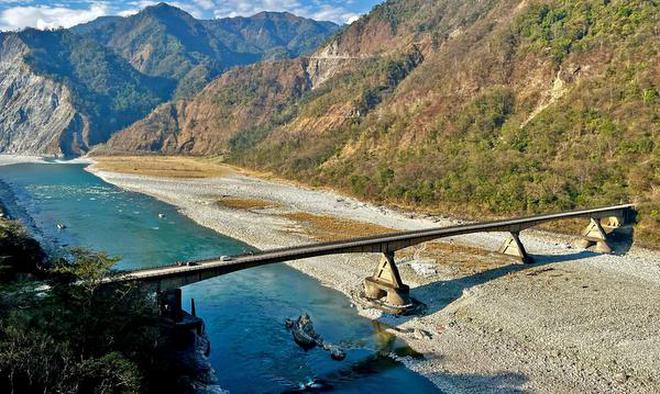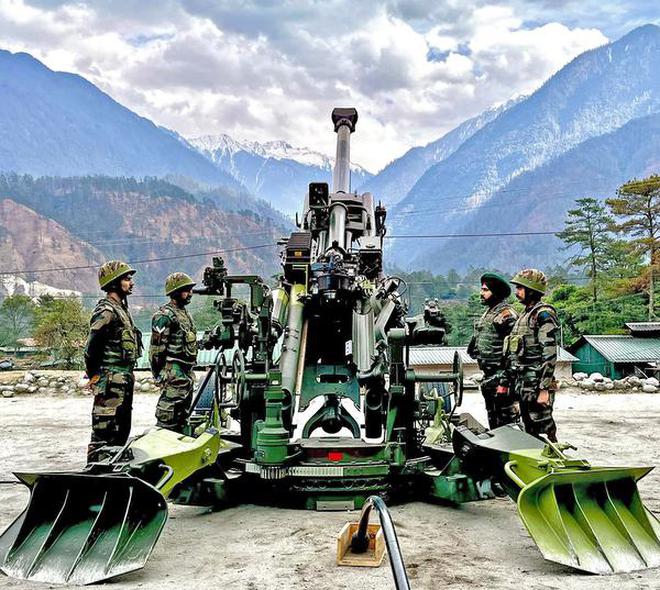Denwa Meyor, 40, and Kunchok Dolma Meyor, 29, are residents of Kibithoo, one of the easternmost villages in Anjaw district of Arunachal Pradesh. Inhabited by people of the Meyor tribe, it is located about 7-8 km from the Line of Actual Control (LAC), the contested line that separates India and China. Their husbands work as porters with the Indian Army, like many men here. Denwa has two children, a 13-year-old daughter and a four-year-old son. Her daughter is in a hostel in Hayuliang, about 135 km away, as Kibithoo’s school runs only until Class 8 and English-medium education is limited in the area. Kunchok has a two-and-half-year-old son. He plays in the sun, oblivious of his mother’s worry about his education. “We want better education [closer home], and in English,” says Denwa. The State-run hostel costs ₹60,000-₹70,000 a year and making the monthly trip to see her daughter is expensive. Over the past year, the village of about 130 residents has witnessed its Primary Health Centre and residences of the schoolteachers being upgraded, and concrete tracks being laid under the Central government’s Vibrant Villages Programme (VVP).
Nijum Manyu, 32, a contractual government teacher from Tezu, 245 km away, who got his first posting in Kibithoo three years ago, says there are four teachers, and the school is being renovated, with a new badminton court as well.
The Army’s demarcation
For administrative purposes, the Army classifies Arunachal as Kameng, derived from the name of the river that flows through the State. Tawang district is part of the Kameng area, while the remaining part of the State is considered separate and was earlier referred to as the Rest of Arunachal Pradesh (RALP).
Of the 3,488-km-long LAC, 1,346 km falls in the eastern sector, comprising Sikkim and Arunachal. While the Tawang and Kameng areas are under the Army’s IV Corps, headquartered at Tezpur, RALP is under the III Corps, which is based at Dimapur. Kameng and Tawang have seen development in the last 10-15 years, with the remaining areas only now catching up with the kind of infrastructure that China possesses.
The VVP was approved as a Centrally-sponsored scheme on February 15, 2023, with an outlay of ₹4,800 crore for the financial years 2022-23 to 2025-26 for the development of 2,967 villages in 46 blocks across 19 districts in the border States of Arunachal Pradesh, Himachal Pradesh, Sikkim, Uttarakhand, and the Union Territory of Ladakh. The objective of the VVP is comprehensive development of these villages to improve the quality of life of people, thereby reversing outmigration, according to the Ministry of Home Affairs. The VVP is an effort to counter China’s model villages — called Xiaokang (moderately prosperous) and located very close to the LAC opposite Uttarakhand, Sikkim, and Arunachal Pradesh — which have raised apprehensions in the security establishment.

In the first phase of the VVP, 662 villages have been identified on priority, of which 455 are in Arunachal, with 245 earmarked in the III Corps area. Out of these, 23 villages have been identified by the Army in Tezu for priority development, officials on the ground say. Union Home Minister Amit Shah formally launched the VVP in Kibithoo on April 10, 2023. He also inaugurated nine micro hydel projects of the State government and 14 infrastructure projects for the Indo-Tibetan Border Police (ITBP). “Captured the beautiful landscapes during my visit to Kibithoo, India’s rst village. Arunachal Pradesh is blessed with immense natural beauty. I urge all to visit Arunachal Pradesh, especially Kibithoo, to be inspired by its history and stunned by nature’s marvels,” the Union Minister said in a post on social media platform X (formerly Twitter), after his visit, along with a video of the mountainous landscape.
Along with Kibithoo, the adjacent villages of Kaho and Meshai, all in the Anjaw district, have together been allotted ₹9.72 crore for infrastructure development, revenue generation, and human resource development. Work is approximately 85% complete, an official says.
Civil-military coordination
Just a few metres from where Denwa and Kunchok live, is Kibithu Bakery, staffed with four young women, in the 20 to 27 age group, who draw a monthly salary of ₹7,500. It was established in 2022 by the Army with the help of the Pune-based Aseem Foundation through funds under Operation Sadbhavna, a social welfare scheme spanning the areas of environment, education, and skilling.
The bakery sells nankhatai (a type of shortbread), coconut and butter cookies, and cake. With tourists trickling in, the Army has lined up a renovation plan that will see new decor, lighting, and seating, estimated to cost between ₹30 lakh and ₹35 lakh. Once there is decent mobile connectivity, expected in the next few months, UPI payments will also be made available, improving ease of payments, officials say.
Civil-military coordination is a prerequisite for the programme in border areas, says Lt. Col. R.S. Manhas, from a unit of the Punjab Regiment deployed in the area. “Our works through Operation Sadbhavna function as a feeder to the VVP,” he says. The Army has allocated ₹15 crore under Operation Sadbhavna for developmental projects and outreach activities in the forward areas in III Corps area for 2022-23. The topography of Arunachal is like a wheel, the flat plateau as the hub with mountains and valleys jutting outwards like spokes. It means for travel between valleys, a visitor must come back to the plains.
Work on the 2,400-km trans-Arunachal highway, which goes along the length of the border, is about 92% complete and the rest is expected to be completed this year, another official says.
The new, almost 1,800-km-long frontier highway, on which work has commenced, will fill a critical void facilitating inter-valley movement. It will start from Bomdila in Arunachal’s west, pass through Nafra, Huri and Monigong villages, and end in Vijaynagar, near the Indo-Myanmar border. The roads cut through eastern Arunachal’s thick forests.

Another 3,000 km of road infrastructure is also under planning and construction in the State. A number of operational tracks are being built by the Army to ensure last-mile connectivity in the forward areas, and in addition, a large number of projects have been sanctioned under the Prime Minister Gati Shakti project for infrastructure development.
A total of 34 new bridges have been constructed between 2020 and 2023, and three are under construction, all of which are Class 70 or higher, which means they have a capacity to carry 70 tonnes of load or higher. “All seven valleys have been connected with Chinook-specific helipads to ensure aerial connectivity,” a source says, meaning they can be used by CH-47F(I) Chinook heavy-lift helicopters of the Air Force, which have emerged as a game changer on the LAC.
Since the 2020 stand-off with China in eastern Ladakh, the Army has carried out a major reorientation of troops from the western borders to the northern and eastern borders, and a change in the Order of Battle (ORBAT), the structural changes involved in maintaining troops and machines. As a part of this, several battalions that were committed to counter-insurgency roles in the Northeast were moved to the LAC.
The Army’s artillery guns — M777 Ultra Light Howitzers and 105mm Indian Field Guns — are deployed close to the LAC. The M777s, with a range of over 30 km, weigh just four tonnes and can be airlifted underslung on Chinooks, giving significant manoeuvrability in terms of long-range firepower between the valleys. Over the last few years, a range of new-generation equipment ranging from SIG-716 rifles, Negev light machine guns, Sako TRG-42 sniper rifles, tactical drones, sensors, and other weapons and equipment have been inducted here.
A new memorial dedicated to the Battle of Walong of 1962 stands tall. In November 1962, the Indian Army halted the advancing People’s Liberation Army soldiers for 27 days, forcing them to commit their reserve division from Tawang sector to Walong. Vastly outnumbered, with little ammunition and no resources, Indian soldiers fought until the last man and the last round. Capturing this, Time wrote in January 1963: “At Walong, Indian troops lacked everything. The only thing they did not lack was guts.”
Another infrastructure development is the connectivity across the Lohit river, which, for India, starts from Kibithoo and flows to Tezu, and then joins the Brahmaputra in Assam, a distance of almost 350 km, dividing the stretch into east and west banks. Three key bridges across the river, to be ready by next year, can handle 80 tonnes of load. “Only 17 suspension bridges between the east and west banks currently exist, the last one at Kibithoo,” an Army official on the ground explains.
From 2G to 4G
Another aspect witnessing tremendous change is mobile connectivity. The Universal Service Obligation Fund (USOF) was established with the fundamental objective of providing access to “basic telegraph services” to people in remote and rural areas at aordable and reasonable prices.
Under the USOF, an agreement was signed with the Bharti Group in 2021 for the commissioning of towers and provision of 4G-based mobile services at 980 sites, covering 1,683 uncovered villages in Arunachal Pradesh, with a roll-out time of 21 months.
An official says 345 sites are being upgraded by Airtel in Lohit, Anjaw, and Dinjan valleys, of which 23 sites have been completed. Similarly, 451 BSNL sites have been selected under the project and 13 2G sites for upgradation to 4G. In the past, mobile phones at Kibithoo would only connect to Chinese networks. Locals would tell the few tourists here to put their phones on flight mode to avoid international roaming charges. However, now phones pick up both Indian and Chinese networks. Officials explain that while towers have been set up, laying optical fibre networks is in progress.
As connectivity improves, efforts are on to promote tourism. Under the Seema Darshan project, the State government, with support from the Army, has approved 12 tourist circuits, including two foreign tourist ones, beyond the Kameng area. Religious tourism to Kepang La, Pasang Sonam Tso Lake, and Taksang Gompa is also being showcased and promoted, an official says, adding that passes for trekking are also being facilitated.







